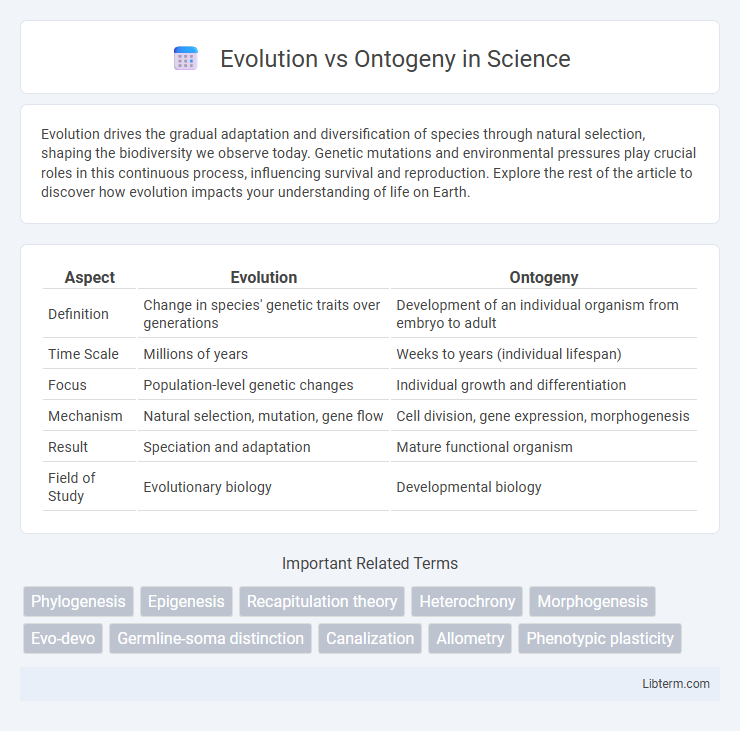Evolution drives the gradual adaptation and diversification of species through natural selection, shaping the biodiversity we observe today. Genetic mutations and environmental pressures play crucial roles in this continuous process, influencing survival and reproduction. Explore the rest of the article to discover how evolution impacts your understanding of life on Earth.
Table of Comparison
| Aspect | Evolution | Ontogeny |
|---|---|---|
| Definition | Change in species' genetic traits over generations | Development of an individual organism from embryo to adult |
| Time Scale | Millions of years | Weeks to years (individual lifespan) |
| Focus | Population-level genetic changes | Individual growth and differentiation |
| Mechanism | Natural selection, mutation, gene flow | Cell division, gene expression, morphogenesis |
| Result | Speciation and adaptation | Mature functional organism |
| Field of Study | Evolutionary biology | Developmental biology |
Understanding Evolution and Ontogeny
Understanding evolution reveals the genetic changes and natural selection processes shaping species over generations, while ontogeny examines the developmental stages of an individual organism from embryo to adult. Evolutionary biology integrates comparative embryology and genetics to trace lineage divergence, highlighting how ontogenetic processes can reflect evolutionary history. Insights into gene regulation during ontogeny elucidate mechanisms driving phenotypic variation, aiding interpretations of evolutionary adaptations.
Key Differences Between Evolution and Ontogeny
Evolution refers to the genetic changes in populations over generations, driven by natural selection, mutation, and genetic drift, shaping species diversity and adaptation. Ontogeny describes the development of an individual organism from fertilization to maturity, encompassing cellular differentiation, morphogenesis, and growth. Key differences include evolution operating at the population level across multiple generations, while ontogeny occurs within a single organism's lifespan, focused on developmental processes and phenotypic expression.
The Role of Genetics in Evolution and Development
Genetics plays a crucial role in both evolution and ontogeny by driving heritable variation that shapes species over generations and guiding gene expression during individual development. Evolution relies on genetic mutations, recombination, and selection to alter allele frequencies in populations, while ontogeny depends on genetic regulatory networks to control cell differentiation and morphogenesis. Understanding the interplay between evolutionary genetics and developmental biology reveals how genetic mechanisms produce phenotypic diversity and complexity across time scales.
Comparative Timelines: Evolutionary Versus Ontogenetic Changes
Evolutionary changes occur over millions of years, shaping species through natural selection and genetic mutations across generations, while ontogenetic changes happen within an individual organism's lifetime, following a developmental timeline from embryo to adult. Comparative timelines reveal that evolutionary processes influence population traits gradually, whereas ontogeny involves rapid, programmed stages like cell differentiation and organogenesis. Understanding these timelines clarifies how long-term genetic evolution contrasts with short-term, species-specific developmental trajectories.
Mechanisms Driving Evolution and Ontogeny
Mechanisms driving evolution include genetic mutation, natural selection, gene flow, and genetic drift, which alter allele frequencies in populations over generations, promoting adaptation and speciation. Ontogeny is governed by molecular signaling pathways, gene regulatory networks, epigenetic modifications, and cellular differentiation processes that guide the development of an organism from a single cell to its mature form. Both evolution and ontogeny rely on genetic information but operate at different biological scales: evolution modifies populations over time, while ontogeny shapes individual organisms during their lifespan.
Examples Illustrating Evolutionary and Ontogenetic Processes
The development of the vertebrate limb exemplifies evolution through the adaptation of fin structures in fish to amphibians and eventually to tetrapods, while ontogeny is observed in the embryonic growth stages where limb buds form and differentiate into specific bones and muscles. The evolution of the eye demonstrates gradual complexity increase over millions of years across species, contrasted by ontogenetic processes showing how a single fertilized cell in an embryo rapidly develops into a fully functioning sensory organ. The comparison between Darwin's finch beak variations across populations and the individual developmental changes in beak shape from hatchling to adult illustrate evolutionary adaptation versus ontogenetic growth, respectively.
Evolutionary Developmental Biology (“Evo-Devo”)
Evolutionary Developmental Biology ("Evo-Devo") explores how genetic and developmental processes influence evolutionary changes, revealing the mechanisms behind morphological diversity across species. Evo-Devo integrates comparative embryology, genetics, and evolutionary theory to understand how developmental pathways evolve and contribute to phenotypic variation. This field highlights the role of gene regulation, such as Hox genes, in shaping evolutionary transformations and the origin of novel traits.
Impacts of Environment on Evolution and Ontogeny
Environmental factors drive evolutionary adaptations by selecting traits that enhance survival and reproduction, shaping species over generations. In ontogeny, environmental influences such as nutrition, toxins, and social interactions affect gene expression and developmental pathways, leading to phenotypic plasticity. Both processes demonstrate how external conditions can produce significant biological variation, influencing species evolution and individual development.
Common Misconceptions: Evolution vs Ontogeny
Evolution refers to genetic changes across generations within populations, while ontogeny describes the development of an individual organism from embryo to adult. A common misconception is that ontogeny recapitulates evolution, implying individual development retraces evolutionary history, which lacks scientific support. Modern biology recognizes that developmental processes are influenced by genetic evolution but do not simply replay ancestral forms.
Future Directions in Evolutionary and Ontogenetic Research
Future directions in evolutionary and ontogenetic research emphasize leveraging genomic and epigenomic technologies to unravel the interplay between genetic variation and developmental processes. Integrating high-resolution single-cell sequencing with advanced computational modeling will illuminate the mechanisms driving phenotypic plasticity and adaptive evolution across life stages. Enhanced cross-disciplinary approaches combining evolutionary biology, developmental genetics, and systems biology promise to deepen our understanding of how ontogenetic trajectories influence macroevolutionary patterns.
Evolution Infographic

 libterm.com
libterm.com